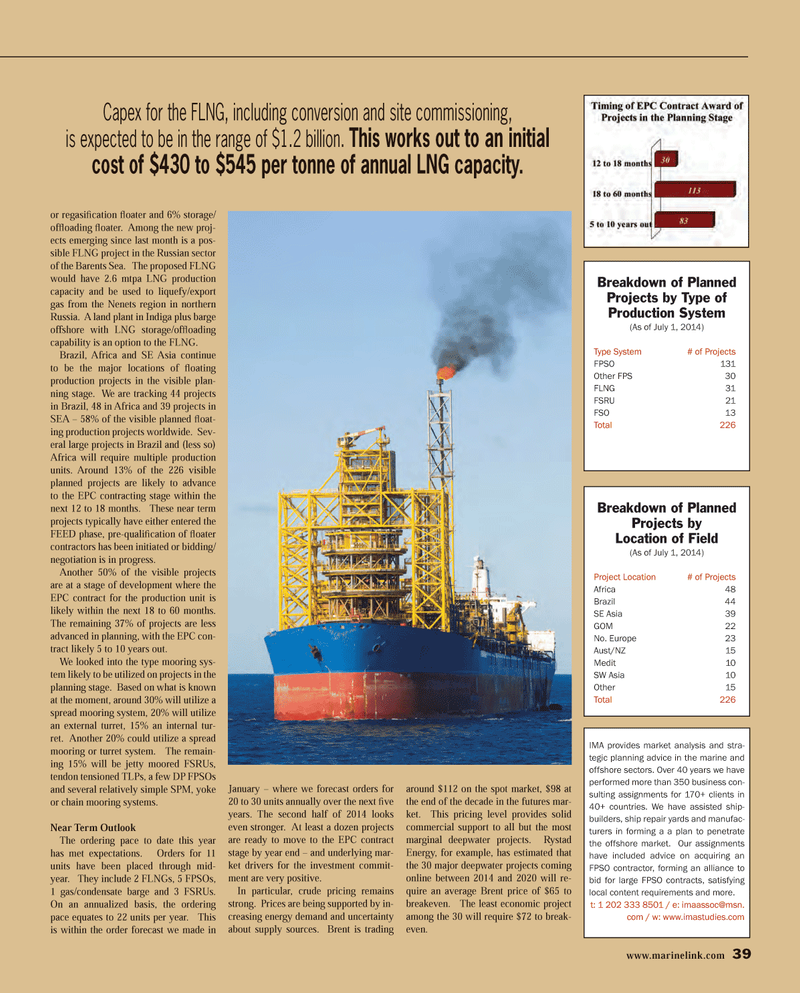
Page 39: of Maritime Reporter Magazine (July 2014)
Offshore Energy Structures & Systems
Read this page in Pdf, Flash or Html5 edition of July 2014 Maritime Reporter Magazine
or regasifi cation fl oater and 6% storage/ offl oading fl oater. Among the new proj- ects emerging since last month is a pos- sible FLNG project in the Russian sector of the Barents Sea. The proposed FLNG would have 2.6 mtpa LNG production capacity and be used to liquefy/export gas from the Nenets region in northern
Russia. A land plant in Indiga plus barge offshore with LNG storage/offl oading capability is an option to the FLNG.
Brazil, Africa and SE Asia continue to be the major locations of fl oating production projects in the visible plan- ning stage. We are tracking 44 projects in Brazil, 48 in Africa and 39 projects in
SEA – 58% of the visible planned fl oat- ing production projects worldwide. Sev- eral large projects in Brazil and (less so)
Africa will require multiple production units. Around 13% of the 226 visible planned projects are likely to advance to the EPC contracting stage within the next 12 to 18 months. These near term projects typically have either entered the
FEED phase, pre-qualifi cation of fl oater contractors has been initiated or bidding/ negotiation is in progress.
Another 50% of the visible projects are at a stage of development where the
EPC contract for the production unit is likely within the next 18 to 60 months.
The remaining 37% of projects are less advanced in planning, with the EPC con- tract likely 5 to 10 years out.
We looked into the type mooring sys- tem likely to be utilized on projects in the planning stage. Based on what is known at the moment, around 30% will utilize a spread mooring system, 20% will utilize an external turret, 15% an internal tur- ret. Another 20% could utilize a spread mooring or turret system. The remain- ing 15% will be jetty moored FSRUs, tendon tensioned TLPs, a few DP FPSOs and several relatively simple SPM, yoke or chain mooring systems.
Near Term Outlook
The ordering pace to date this year has met expectations. Orders for 11 units have been placed through mid- year. They include 2 FLNGs, 5 FPSOs, 1 gas/condensate barge and 3 FSRUs.
On an annualized basis, the ordering pace equates to 22 units per year. This is within the order forecast we made in
January – where we forecast orders for 20 to 30 units annually over the next fi ve years. The second half of 2014 looks even stronger. At least a dozen projects are ready to move to the EPC contract stage by year end – and underlying mar- ket drivers for the investment commit- ment are very positive.
In particular, crude pricing remains strong. Prices are being supported by in- creasing energy demand and uncertainty about supply sources. Brent is trading around $112 on the spot market, $98 at the end of the decade in the futures mar- ket. This pricing level provides solid commercial support to all but the most marginal deepwater projects. Rystad
Energy, for example, has estimated that the 30 major deepwater projects coming online between 2014 and 2020 will re- quire an average Brent price of $65 to breakeven. The least economic project among the 30 will require $72 to break- even. www.marinelink.com 39
IMA provides market analysis and stra- tegic planning advice in the marine and offshore sectors. Over 40 years we have performed more than 350 business con- sulting assignments for 170+ clients in 40+ countries. We have assisted ship- builders, ship repair yards and manufac- turers in forming a a plan to penetrate the offshore market. Our assignments have included advice on acquiring an
FPSO contractor, forming an alliance to bid for large FPSO contracts, satisfying local content requirements and more. t: 1 202 333 8501 / e: imaassoc@msn. com / w: www.imastudies.com
Breakdown of Planned
Projects by
Location of Field (As of July 1, 2014)
Project Location # of Projects
Africa 48
Brazil 44
SE Asia 39
GOM 22
No. Europe 23
Aust/NZ 15
Medit 10
SW Asia 10
Other 15
Total 226
Breakdown of Planned
Projects by Type of
Production System (As of July 1, 2014)
Type System # of Projects
FPSO 131
Other FPS 30
FLNG 31
FSRU 21
FSO 13
Total 226
Capex for the FLNG, including conversion and site commissioning, is expected to be in the range of $1.2 billion. This works out to an initial cost of $430 to $545 per tonne of annual LNG capacity.
MR #7 (32-41).indd 39 7/2/2014 1:33:30 PM

 38
38

 40
40
